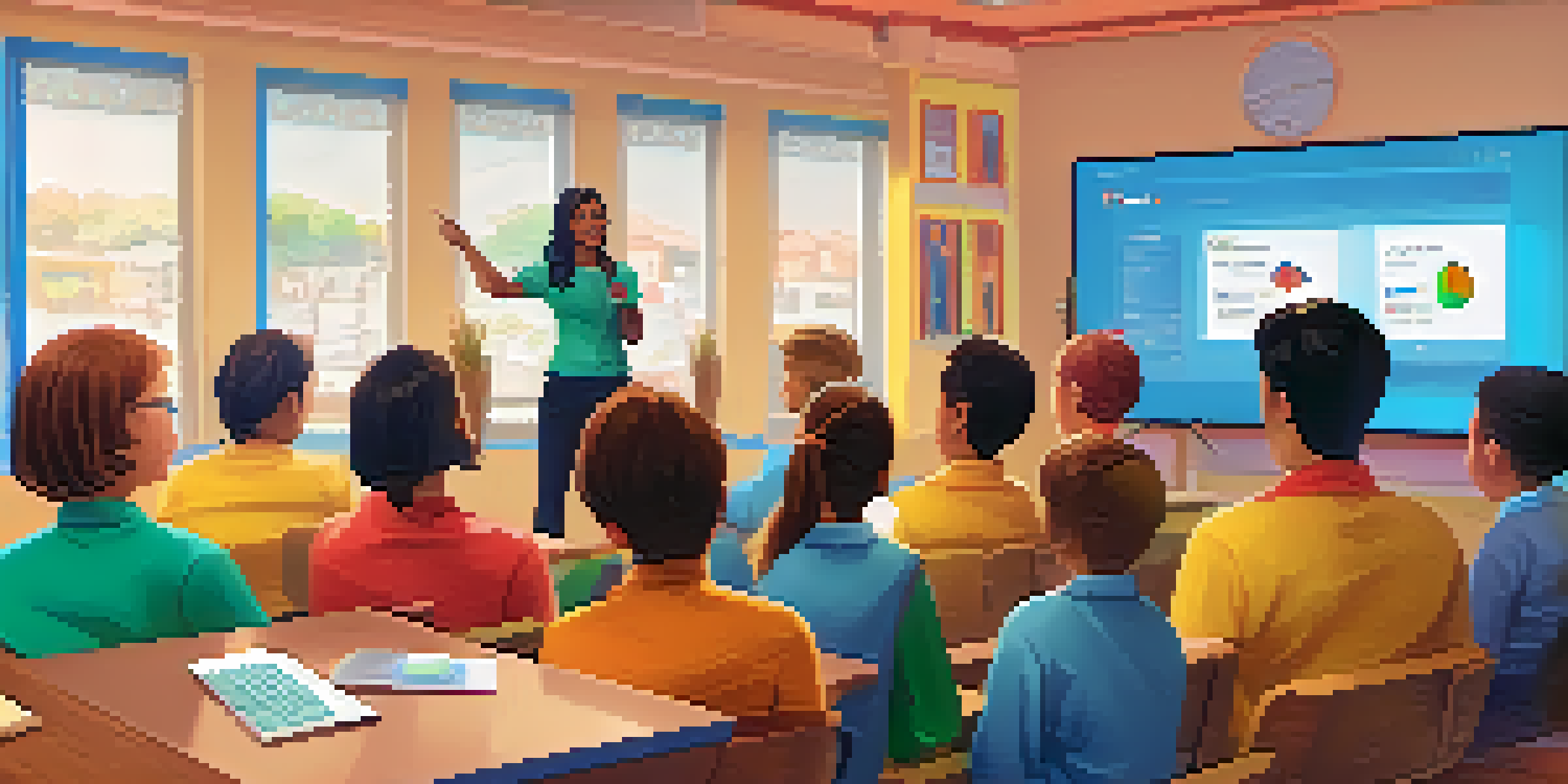The Role of Video Conferencing in Digital Education Collaboration

Understanding Video Conferencing in Education
Video conferencing has transformed the way education is delivered, allowing students and teachers to connect in real-time, regardless of location. This technology enables face-to-face interactions through platforms like Zoom and Microsoft Teams, making remote learning more personal and engaging. By replicating the in-class experience online, video conferencing bridges the gap between traditional and digital education.
Education is not the filling of a pail, but the lighting of a fire.
For instance, a teacher in New York can easily conduct a live class with students from California or even overseas. This not only broadens the learning horizon but also enriches the educational experience with diverse perspectives. As a result, video conferencing is a vital tool that supports collaborative learning.
Moreover, it fosters a sense of community among students and educators, which is often missing in traditional online courses. By enhancing social interaction, video conferencing helps build relationships that are crucial in a learning environment, making education feel more connected and less isolated.
Enhancing Collaboration through Real-Time Communication
One of the standout features of video conferencing is its ability to facilitate real-time communication. This immediacy allows for dynamic discussions, where students can ask questions and receive instant feedback, much like they would in a physical classroom. This back-and-forth interaction significantly enhances the collaborative experience.

Imagine a group project where students can brainstorm ideas in real-time, share their screens, and work together on presentations. This collaborative environment not only boosts creativity but also encourages accountability among group members, as everyone is present and engaged. Such interactions make learning more effective and enjoyable.
Transforming Education with Technology
Video conferencing connects students and teachers in real-time, enhancing the learning experience beyond geographical barriers.
Furthermore, the use of features like breakout rooms allows for smaller group discussions, promoting deeper engagement. Students can work on specific tasks and then come back to share their findings, ensuring that everyone contributes to the collective learning process.
Access to Diverse Resources and Expertise
Video conferencing opens the door to a wealth of resources and expertise that students may not have access to locally. By inviting guest speakers or industry professionals from around the world, educators can enrich their curriculum with real-world insights and experiences. This exposure is invaluable for students as they prepare for their future careers.
The beautiful thing about learning is that no one can take it away from you.
For example, a business class could host a CEO from a leading company to discuss market trends and strategies. Such interactions provide students with practical knowledge and networking opportunities that can significantly enhance their learning experience. This accessibility is a game-changer in digital education.
Additionally, recorded sessions of video conferences can serve as a valuable resource for students to revisit complex topics at their own pace. This flexibility not only caters to different learning styles but also reinforces understanding, making education more comprehensive.
Building Skills for the Digital Workforce
As the job market increasingly leans towards remote work, video conferencing plays a crucial role in preparing students for the digital workforce. By regularly engaging in virtual meetings, students develop essential skills such as communication, collaboration, and digital literacy. These competencies are highly sought after by employers today.
Participating in video conferences helps students become comfortable with technology and enhances their ability to navigate various digital tools. This experience is not just beneficial for academic purposes but also translates well into professional scenarios where virtual meetings are commonplace.
Fostering Collaboration and Skills
Real-time communication through video conferencing boosts collaboration and helps students develop essential skills for the digital workforce.
Moreover, the practice of presenting ideas and projects in front of peers via video conferencing builds confidence and public speaking skills. These soft skills are invaluable, giving students a competitive edge as they enter the workforce.
Creating an Inclusive Learning Environment
Video conferencing can significantly enhance inclusivity in education by accommodating diverse learning needs. For students with disabilities, the ability to attend classes from home can remove barriers that might exist in a traditional classroom setting. This flexibility ensures that everyone has the opportunity to participate and succeed.
Additionally, features such as closed captioning and the ability to record sessions make learning more accessible for all students. These options allow learners to revisit lessons at their convenience, catering to different paces of learning and ensuring no one is left behind.
Inclusivity goes beyond accessibility; it also fosters a sense of belonging among students from various backgrounds. Video conferencing encourages diverse interactions and discussions, enriching the educational experience and promoting empathy and understanding.
Challenges and Solutions in Video Conferencing
Despite its many benefits, video conferencing does come with challenges that educators must navigate. Technical issues, such as poor internet connectivity or unfamiliarity with the software, can disrupt the learning experience. However, with proper training and resources, both educators and students can overcome these hurdles.
To mitigate these challenges, schools can provide virtual training sessions before classes begin, ensuring everyone feels confident using the technology. Additionally, having technical support readily available during classes can help address issues promptly, minimizing disruptions.
Promoting Inclusivity in Learning
Video conferencing accommodates diverse learning needs, creating an inclusive environment that supports participation and understanding.
Moreover, fostering a culture of patience and understanding among participants can enhance the overall experience. Encouraging students to communicate their needs and challenges openly can lead to collaborative solutions, making the learning environment more resilient.
The Future of Video Conferencing in Education
As technology continues to evolve, the role of video conferencing in education will likely expand even further. Innovations such as virtual reality (VR) and augmented reality (AR) are on the horizon, promising to create even more immersive learning experiences. These advancements could make video conferencing not just a tool for communication but a platform for interactive learning.
Imagine a biology class where students can explore the human body in 3D through VR while discussing their findings via video conference. Such experiences can transform the way students engage with material, making learning more interactive and memorable.

Ultimately, the integration of video conferencing in education is paving the way for a more flexible, inclusive, and engaging learning environment. As educators continue to embrace this technology, the possibilities for collaboration and innovation are limitless.